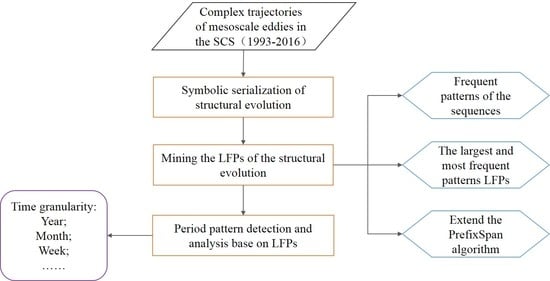Mining Evolution Patterns from Complex Trajectory Structures—A Case Study of Mesoscale Eddies in the South China Sea
Abstract
:1. Introduction
2. Materials and Methods
2.1. The Data Sets
2.2. Mining Periodic Pattern from Complex Trajectories
2.2.1. Translation of a Complex Trajectory to a Symbol Sequence
2.2.2. The Largest and Most Frequent Pattern (LFP)
2.2.3. Mining the LFPs Using the PPSE Method
3. Results
3.1. The LFP Analysis
3.2. Periodic Pattern Discovery
4. Discussion
5. Conclusions
Author Contributions
Funding
Conflicts of Interest
References
- Mamoulis, N.; Cao, H.; Kollios, G. Mining, Indexing, and Querying Historical Spatiotemporal Data. In Proceedings of the Tenth ACM SIGKDD International Conference on Knowledge Discovery and Data Mining, Seattle, WA, USA, 25–25 August 2004; pp. 236–245. [Google Scholar]
- Cao, H.; Mamoulis, N.; Cheung, D.W. Discovery of Periodic Patterns in Spatiotemporal Sequences. IEEE Trans. Knowl. Data Eng. 2007, 19, 453–467. [Google Scholar] [CrossRef] [Green Version]
- Jindal, T.; Giridhar, P.; Tang, L.A. Spatiotemporal Periodical Pattern Mining in Traffic Data. In Proceedings of the 2nd ACM SIGKDD International Workshop on Urban Computing, Chicago, IL, USA, 11–14 August 2013. [Google Scholar]
- Zhang, D.; Lee, K.; Lee, I. Semantic periodic pattern mining from spatio-temporal trajectories. Inf. Sci. 2019, 502, 164–189. [Google Scholar] [CrossRef]
- Nan, F.; He, Z.; Zhou, H.; Wang, N. Three long-lived anticyclonic eddies in the northern South China Sea. J. Geophys. Res. Space Phys. 2011, 116. [Google Scholar] [CrossRef]
- Yi, J.; Du, Y.; Liang, F.; Zhou, C.; Wu, D.; Mo, Y. A representation framework for studying spatiotemporal changes and interactions of dynamic geographic phenomena. Int. J. Geogr. Inf. Sci. 2014, 28, 1010–1027. [Google Scholar] [CrossRef]
- Wang, H.; Du, Y.; Yi, J.; Sun, Y.; Liang, F. A New Method for Measuring Topological Structure Similarity between Complex Trajectories. IEEE Trans. Knowl. Data Eng. 2019, 31, 1836–1848. [Google Scholar] [CrossRef]
- Agrawal, R.; Srikant, R. Mining Sequential Patterns. In Proceedings of the Eleventh International Conference on Data Engineering, Taipei, Taiwan, 6–10 March 1995. [Google Scholar]
- Han, J.W.; Gong, W.; Yin, Y.W. Mining Segment-Wise Periodic Patterns in Time-Related Databases. In Proceedings of the 4th International Conference on Knowledge Discovery and Data Mining, New York, NY, USA, 27 August 1998. [Google Scholar]
- Pei, J.; Han, J.; Mortazavi-Asl, B.; Wang, J.; Pinto, H.; Chen, Q.; Dayal, U.; Hsu, M.-C. Mining sequential patterns by pattern-growth: The PrefixSpan approach. IEEE Trans. Knowl. Data Eng. 2004, 16, 1424–1440. [Google Scholar] [CrossRef] [Green Version]
- Nurulhaq, N.Z.; Sitanggang, I.S. Sequential Pattern Mining on hotspot data in Riau province using the PrefixSpan algorithm. In Proceedings of the International Conference on Adaptive & Intelligent Agroindustry, Bogor, Indonesia, 3–4 August 2015. [Google Scholar]
- Yang, K.-J.; Hong, T.-P.; Chen, Y.-M.; Lan, G.-C. Projection-based partial periodic pattern mining for event sequences. Expert Syst. Appl. 2013, 40, 4232–4240. [Google Scholar] [CrossRef]
- He, Z.; Wang, X.S.; Lee, B.S.; Ling, A.C.H. Mining partial periodic correlations in time series. Knowl. Inf. Syst. 2006, 15, 31–54. [Google Scholar] [CrossRef]
- Yuan, G.; Zhao, J.; Xia, S.; Zhang, Y.; Li, W. Multi-granularity periodic activity discovery for moving objects. Int. J. Geogr. Inf. Sci. 2016, 31, 435–462. [Google Scholar] [CrossRef]
- Ying, J.J.-C.; Lee, W.-C.; Tseng, V.S. Mining geographic-temporal-semantic patterns in trajectories for location prediction. ACM Trans. Intell. Syst. Technol. 2013, 5, 1–33. [Google Scholar] [CrossRef]
- Cui, W.; Wang, W.; Zhang, J.; Yang, J. Multicore structures and the splitting and merging of eddies in global oceans from satellite altimeter data. Ocean Sci. 2019, 15, 413–430. [Google Scholar] [CrossRef] [Green Version]
- Zhang, Z.; Wang, W.; Qiu, B. Oceanic mass transport by mesoscale eddies. Science 2014, 345, 322–324. [Google Scholar] [CrossRef] [PubMed]
- Rodríguez-Marroyo, R.; Viúdez, Á; Ruiz, S. Vortex Merger in Oceanic Tripoles. J. Phys. Oceanogr. 2011, 41, 1239–1251. [Google Scholar] [CrossRef] [Green Version]
- Li, Q.-Y.; Sun, L.; Lin, S.-F. GEM: A dynamic tracking model for mesoscale eddies in the ocean. Ocean Sci. 2016, 12, 1249–1267. [Google Scholar] [CrossRef] [Green Version]
- Yi, J.; Du, Y.; He, Z.; Zhou, C. Enhancing the accuracy of automatic eddy detection and the capability of recognizing the multi-core structures from maps of sea level anomaly. Ocean Sci. 2014, 10, 39–48. [Google Scholar] [CrossRef] [Green Version]
- Yi, J.; Du, Y.; Liang, F.; Zhou, C. An auto-tracking algorithm for mesoscale eddies using global nearest neighbor filter. Limnol. Oceanogr. Methods 2017, 15, 276–290. [Google Scholar] [CrossRef]
- Pujol, M.; Faugère, Y.; Taburet, G.; Dupuy, S.; Pelloquin, C.; Ablain, M.; Picot, N. DUACS DT2014: The new multi-mission altimeter data set reprocessed over 20 years. Ocean Sci. 2016, 12, 1067–1090. [Google Scholar] [CrossRef] [Green Version]
- Okubo, A. Horizontal dispersion of floatable particles in the vicinity of velocity singularities such as convergences. Deep Sea Res. Oceanogr. Abstr. 1970, 17, 445–454. [Google Scholar] [CrossRef]
- Weiss, J. The dynamics of enstrophy transfer in two-dimensional hydrodynamics. Phys. D Nonlinear Phenom. 1991, 48, 273–294. [Google Scholar] [CrossRef]
- Chelton, D.B.; Schlax, M.G.; Samelson, R.M. Global observations of nonlinear mesoscale eddies. Progr. Oceanogr. 2011, 91, 167–216. [Google Scholar] [CrossRef]
- Morrow, R.; Birol, F.; Griffin, D.; Sudre, J. Divergent pathways of cyclonic and anti-cyclonic ocean eddies. Geophys. Res. Lett. 2004, 31, 24311. [Google Scholar] [CrossRef]
- Henson, S.; Thomas, A.C. A census of oceanic anticyclonic eddies in the Gulf of Alaska. Deep Sea Res. Part I Oceanogr. Res. Pap. 2008, 55, 163–176. [Google Scholar] [CrossRef]
- Chen, G.; Hou, Y.; Chu, X. Mesoscale eddies in the South China Sea: Mean properties, spatiotemporal variability, and impact on thermohaline structure. J. Geophys. Res. Space Phys. 2011, 116, 1–20. [Google Scholar] [CrossRef]
- Sudre, J.; Maes, C.; Garçon, V. On the global estimates of geostrophic and Ekman surface currents. Limnol. Oceanogr. Fluids Environ. 2013, 3, 1–20. [Google Scholar] [CrossRef] [Green Version]
- Luo, C.; Chung, S.M. A scalable algorithm for mining maximal frequent sequences using a sample. Knowl. Inf. Syst. 2007, 15, 149–179. [Google Scholar] [CrossRef]
- Wang, H.; Du, Y.; Sun, Y.; Liang, F.; Yi, J.; Wang, N. Clustering Complex Trajectories Based on Topologic Similarity and Spatial Proximity: A Case Study of the Mesoscale Ocean Eddies in the South China Sea. ISPRS Int. J. Geo-Inf. 2019, 8, 574. [Google Scholar] [CrossRef] [Green Version]
- Lin, P.F.; Fan, W.; Chen, Y.L. Temporal and spatial variation characteristics on eddies in the South China Sea I. Statistical analyses. Acta Oceanol. Sin. 2008, 29, 14–22. [Google Scholar]
- Nan, F.; Xue, H.; Yu, F. Kuroshio intrusion into the South China Sea: A review. Prog. Oceanogr. 2015, 137, 314–333. [Google Scholar] [CrossRef] [Green Version]
- Chen, G.; Hou, Y.; Zhang, Q.; Chu, X. The eddy pair off eastern Vietnam: Interannual variability and impact on thermohaline structure. Cont. Shelf Res. 2010, 30, 715–723. [Google Scholar] [CrossRef]
- Yang, H.; Wu, L.; Liu, H.; Yu, Y. Eddy energy sources and sinks in the South China Sea. J. Geophys. Res. Oceans 2013, 118, 4716–4726. [Google Scholar] [CrossRef]
- Wang, G. Mesoscale eddies in the South China Sea observed with altimeter data. Geophys. Res. Lett. 2003, 30, 2121. [Google Scholar] [CrossRef] [Green Version]
- Gan, J.; Qu, T. Coastal jet separation and associated flow variability in the southwest South China Sea. Deep Sea Res. Part. I Oceanogr. Res. Pap. 2008, 55, 1–19. [Google Scholar] [CrossRef]
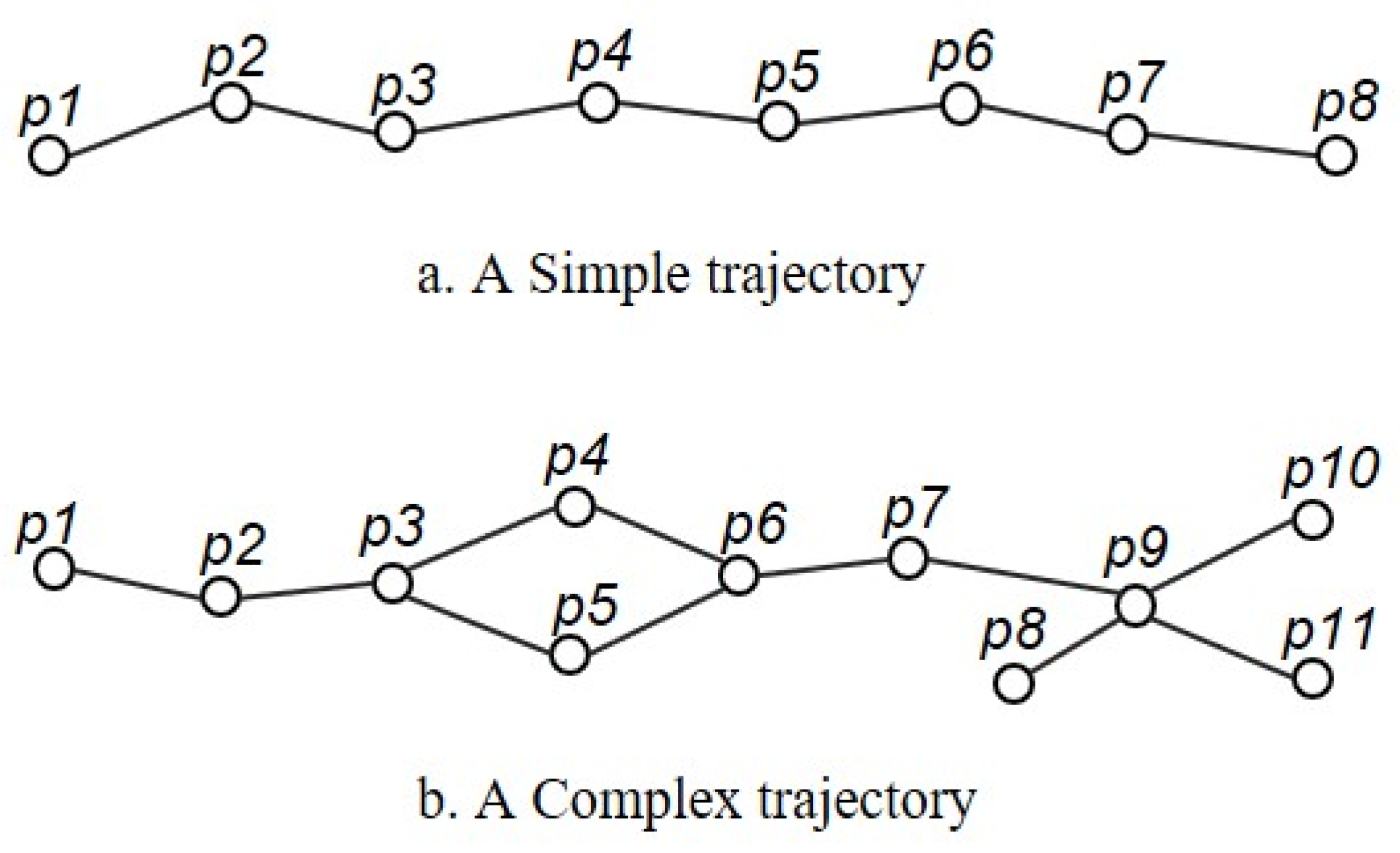

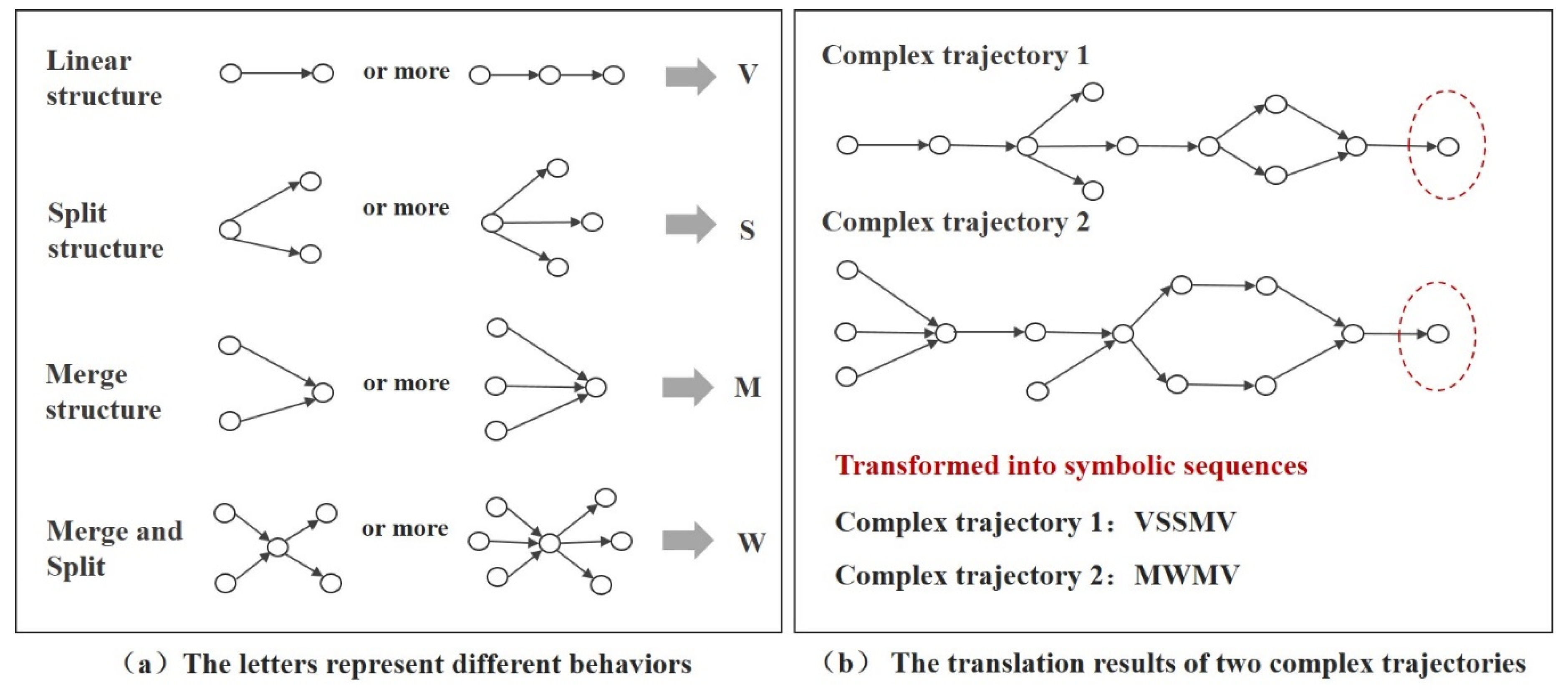

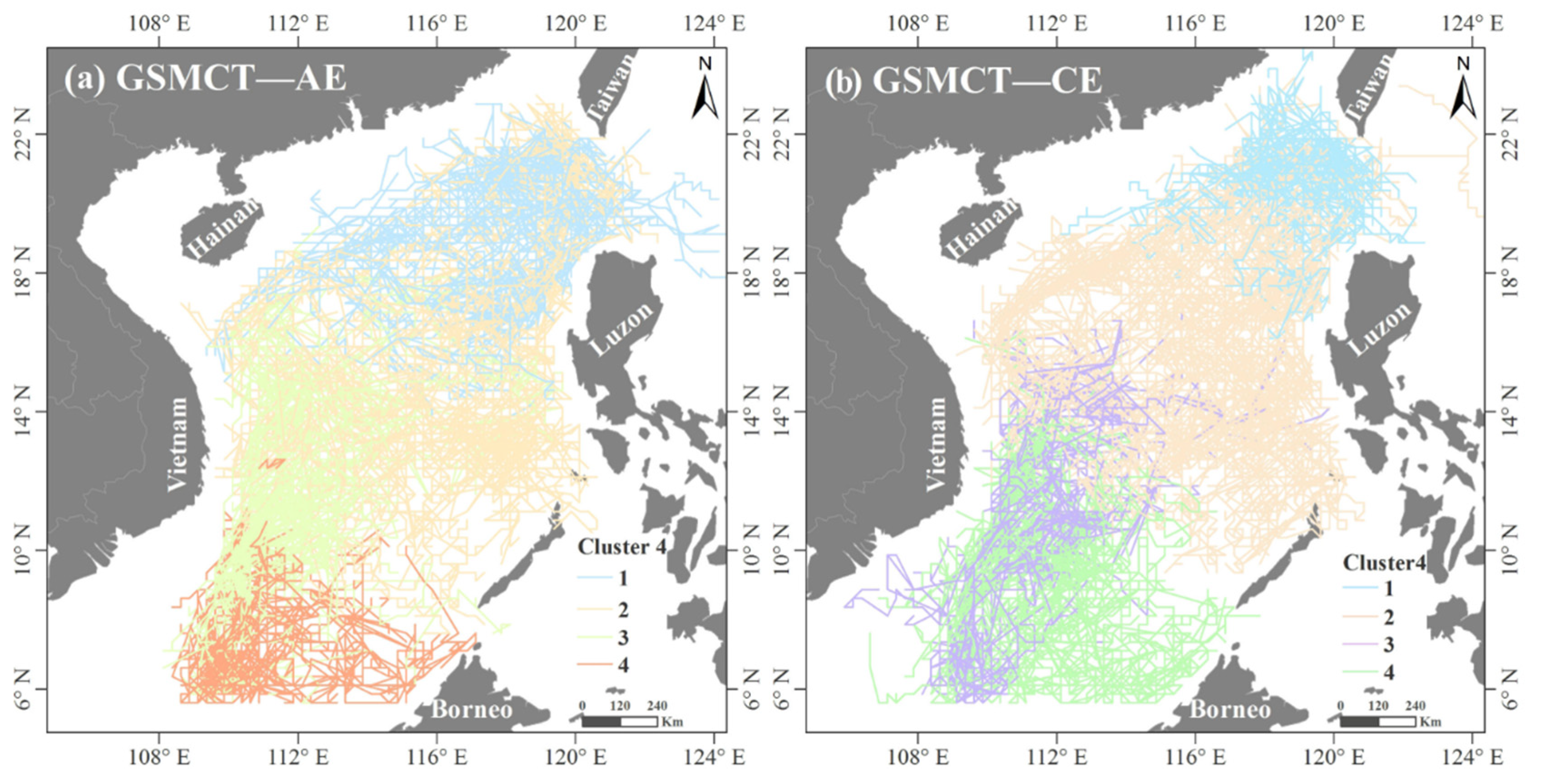
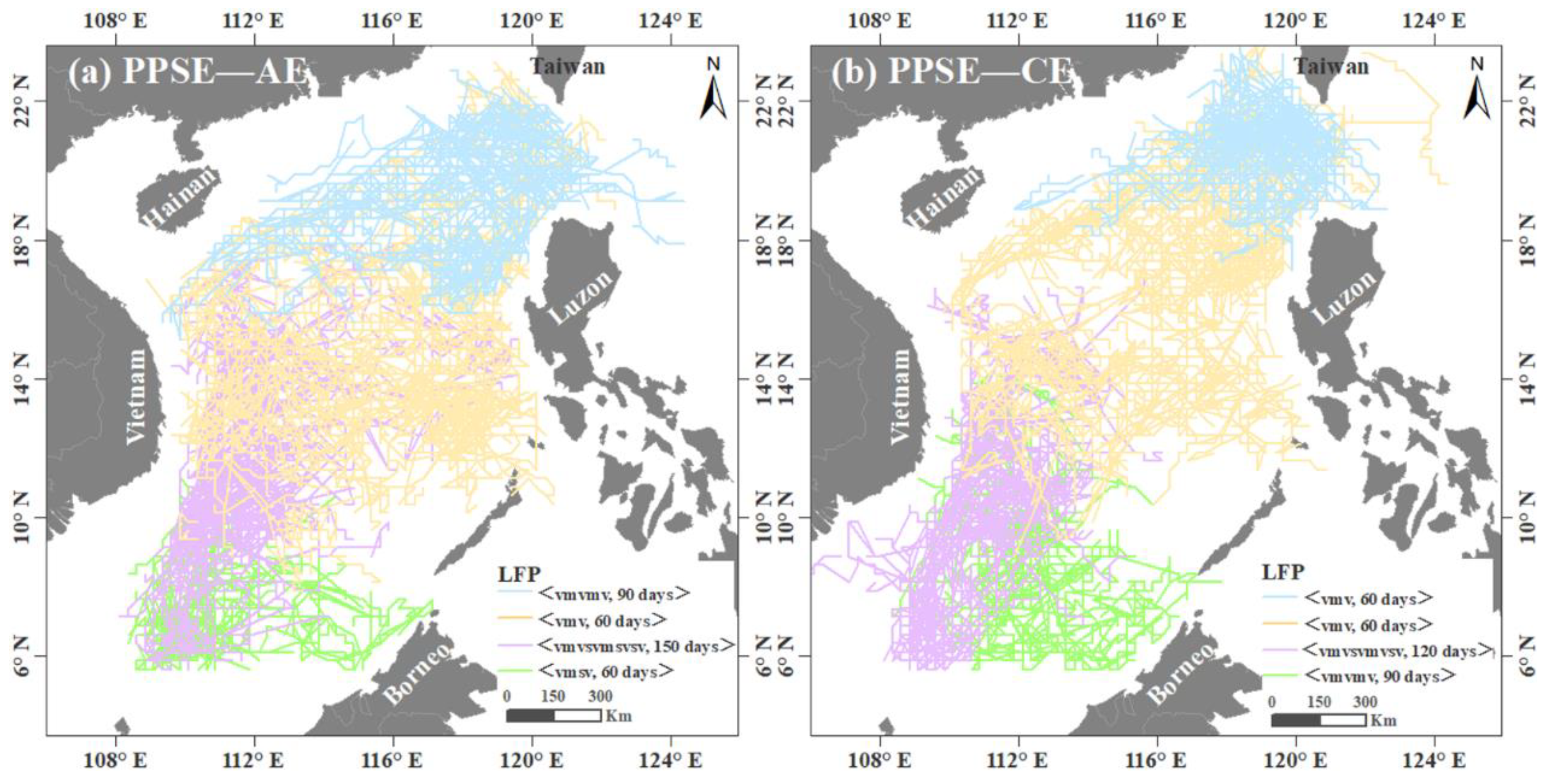


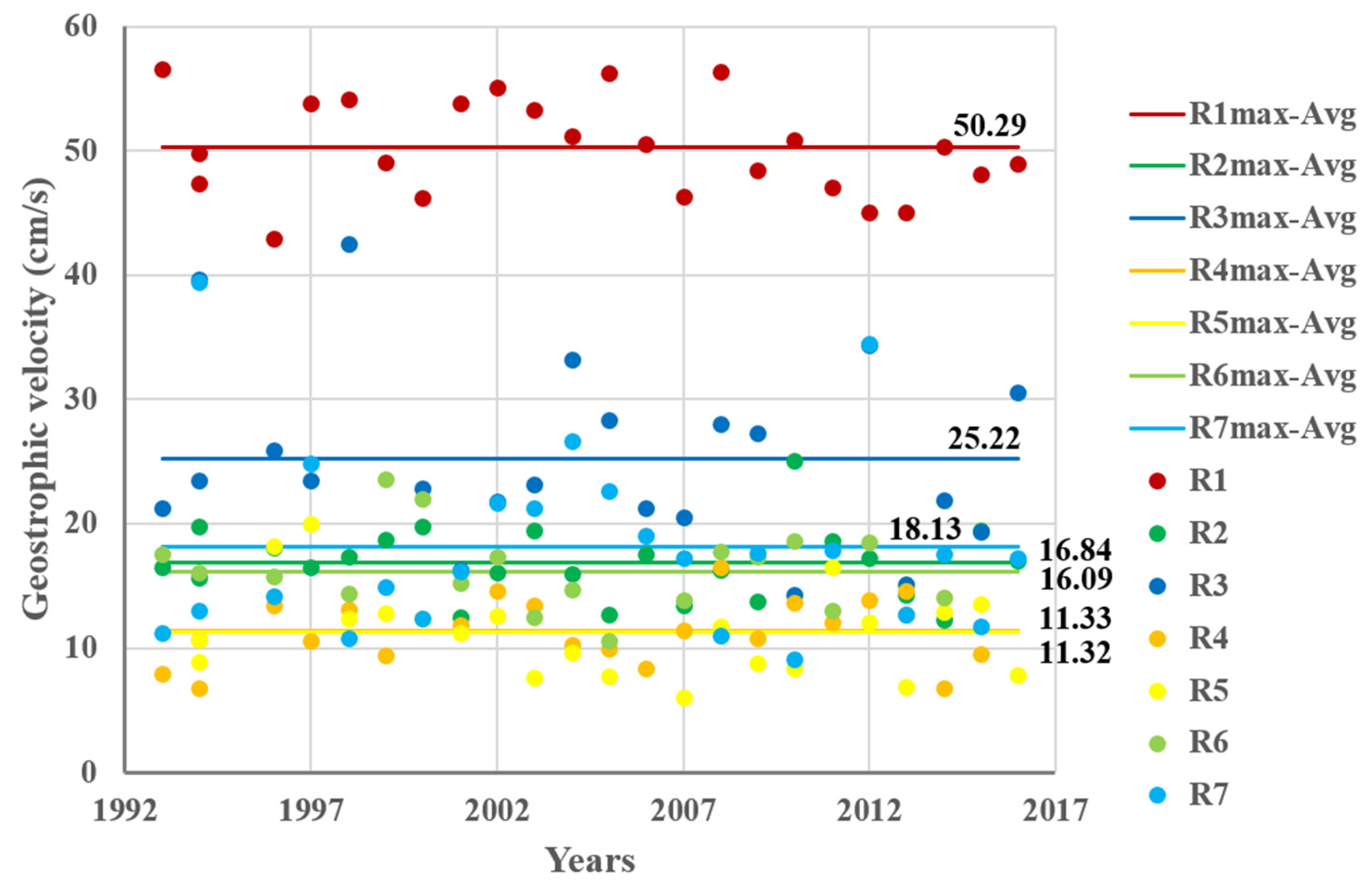
| Space area (Pattern) | AE | CE |
|---|---|---|
| Northern cluster: LFP 1 | <vmvmv, 90, 52(62%)> | <vmv, 60, 84(63%)> |
| Central cluster: LFP 2 | <vmv, 60, 228(59%)> | <vmv, 60, 250(60%)> |
| Southeast of Vietnam: LFP 3 | <vmvsvmsvsv, 150, 33(75%)> | <vmvsvmvsv, 120, 26(57%)> |
| Southern cluster: LFP 4 | <vmsv, 60, 70(55%)> | <vmvmv, 90, 78(59%)> |
| LFP | AE Mobile channel R: cycle years | CE Mobile channel R: cycle years |
|---|---|---|
| LFP 1 | R1 (21 years): 1993, 1994, 1995, 1996, 1997, 1998, 1999, 2000, 2001, 2002, 2003, 2004, 2005, 2006, 2007, 2008, 2011, 2012, 2013, 2015, 2016 R2 (20 years): 1993, 1995, 1996, 1997, 1998, 1999, 2000, 2001, 2002, 2003, 2005, 2006, 2007, 2008, 2011, 2012, 2013, 2014, 2015, 2016 | R1 (23 years): 1993, 1994, 1995, 1996, 1997, 1998, 1999, 2000, 2001, 2002, 2003, 2004, 2005, 2006, 2007, 2009, 2010, 2011, 2012, 2013, 2014, 2015, 2016 |
| LFP 2 | R4 (22 years): 1993, 1994, 1995, 1996, 1997, 1998, 1999, 2001, 2002, 2003, 2004, 2005, 2006, 2007, 2008, 2009, 2010, 2011, 2012, 2013, 2014, 2015, | R2 (20 years): 1993, 1994, 1995, 1997, 1998, 1999, 2000, 2001, 2002, 2003, 2004, 2005, 2007, 2008, 2009, 2010, 2011, 2012, 2013, 2016 R6 (19 years): 1993, 1994, 1996, 1998, 1999, 2000, 2001, 2002, 2003, 2004, 2005, 2007, 2008, 2009, 2010, 2011, 2012, 2013, 2014, |
| LFP 3 | R3 (17 years): 1994, 1995, 1996, 1997, 1998, 2000, 2001, 2004, 2005, 2007, 2008, 2009, 2012, 2013, 2014, 2015, 2016 | R3 (17 years): 1993, 1994, 1995, 1996, 1997, 2000, 2001, 2002, 2003, 2006, 2008, 2009, 2010, 2012, 2013, 2014, 2016 |
| LFP 4 | R5 (22 years): 1994, 1995, 1996, 1997, 1998, 1999, 2000, 2001, 2002, 2003, 2004, 2005, 2007, 2008, 2009, 2010, 2011, 2012, 2013, 2014, 2015, 2016 | R7 (24 years): 1993, 1994, 1995, 1996, 1997, 1998, 1999, 2000, 2001, 2002, 2003, 2004, 2005, 2006, 2007, 2008, 2009, 2010, 2011, 2012, 2013, 2014, 2015, 2016 |
© 2020 by the authors. Licensee MDPI, Basel, Switzerland. This article is an open access article distributed under the terms and conditions of the Creative Commons Attribution (CC BY) license (http://creativecommons.org/licenses/by/4.0/).
Share and Cite
Wang, H.; Du, Y.; Yi, J.; Wang, N.; Liang, F. Mining Evolution Patterns from Complex Trajectory Structures—A Case Study of Mesoscale Eddies in the South China Sea. ISPRS Int. J. Geo-Inf. 2020, 9, 441. https://0-doi-org.brum.beds.ac.uk/10.3390/ijgi9070441
Wang H, Du Y, Yi J, Wang N, Liang F. Mining Evolution Patterns from Complex Trajectory Structures—A Case Study of Mesoscale Eddies in the South China Sea. ISPRS International Journal of Geo-Information. 2020; 9(7):441. https://0-doi-org.brum.beds.ac.uk/10.3390/ijgi9070441
Chicago/Turabian StyleWang, Huimeng, Yunyan Du, Jiawei Yi, Nan Wang, and Fuyuan Liang. 2020. "Mining Evolution Patterns from Complex Trajectory Structures—A Case Study of Mesoscale Eddies in the South China Sea" ISPRS International Journal of Geo-Information 9, no. 7: 441. https://0-doi-org.brum.beds.ac.uk/10.3390/ijgi9070441





